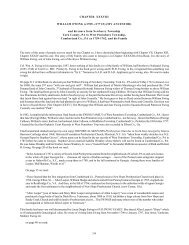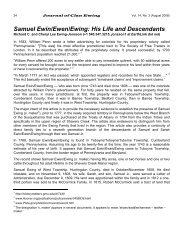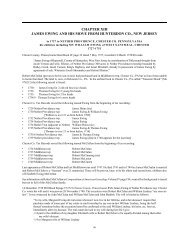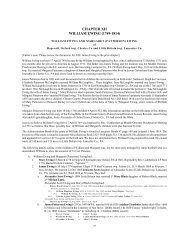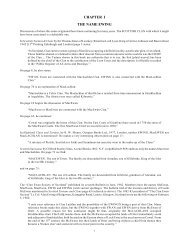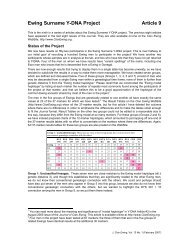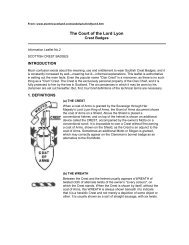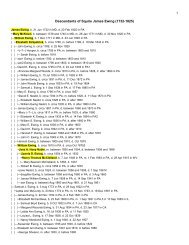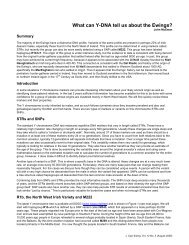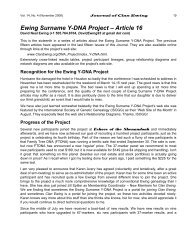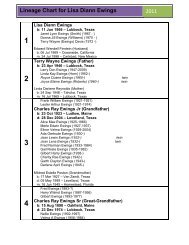Origins of the MacEoghainn clan - Ewing Family Association
Origins of the MacEoghainn clan - Ewing Family Association
Origins of the MacEoghainn clan - Ewing Family Association
Create successful ePaper yourself
Turn your PDF publications into a flip-book with our unique Google optimized e-Paper software.
Page 1<br />
<strong>Origins</strong> <strong>of</strong> <strong>the</strong> <strong>MacEoghainn</strong> <strong>clan</strong>: What<br />
information can Y chromosome markers<br />
provide?<br />
John McEwan<br />
10 th July 2005<br />
The intention <strong>of</strong> this article is to provide background to <strong>the</strong> Y chromosome<br />
investigation we are attempting to undertake into <strong>the</strong> origins <strong>of</strong> <strong>the</strong> <strong>Ewing</strong> and<br />
McEwen surname variants. There is no guarantee <strong>of</strong> success <strong>of</strong> <strong>the</strong> project<br />
and it may take some time before we are in a position to judge <strong>the</strong> outcome.<br />
The objective is to identify if <strong>the</strong> oral and written history <strong>of</strong> <strong>the</strong> <strong>clan</strong> and weigh<br />
it on <strong>the</strong> scales <strong>of</strong> <strong>the</strong> information DNA provides. Specifically, <strong>the</strong> article<br />
reviews <strong>the</strong> recorded origins <strong>of</strong> <strong>the</strong> <strong>MacEoghainn</strong> surname and <strong>the</strong>n<br />
describes some potential investigations that can be done using <strong>the</strong> DNA data.<br />
Later articles will describe <strong>the</strong> results <strong>of</strong> work to address <strong>the</strong>se questions.<br />
Surnames<br />
Surnames largely became fixed in England and Ireland during <strong>the</strong> period<br />
1000-1200 AD, but in Scotland <strong>the</strong>y are primarily related to <strong>the</strong> <strong>clan</strong> system.<br />
The reason for surnames derives from <strong>the</strong> Norman invasion and various<br />
aspects <strong>of</strong> <strong>the</strong> feudal system. However, detailed genealogies were a feature<br />
<strong>of</strong> Celtic life and many Scottish <strong>clan</strong>s can trace <strong>the</strong>ir ancestry (at least as an<br />
oral tradition) back 1500 to 2000 years.<br />
Accepted origin<br />
The available oral and written tradition is that <strong>the</strong> Scottish <strong>MacEoghainn</strong> <strong>clan</strong><br />
(to use a Gaelic rendering <strong>of</strong> <strong>the</strong> name which means “son <strong>of</strong> Ewen”) originally<br />
resided in Argyll. When transliterated into English, from Gaelic this became<br />
<strong>Ewing</strong>, McEwen, McEwan and o<strong>the</strong>r associated variants. In tracing my own<br />
family <strong>the</strong> earliest spelling <strong>of</strong> <strong>the</strong> name was Mc<strong>Ewing</strong> in <strong>the</strong> late 1700s, <strong>the</strong>n<br />
McEwen and after 1870 when <strong>the</strong>y had shifted from Islay to <strong>the</strong> Glasgow area<br />
McEwan. Investigation <strong>of</strong> Scottish census records show similar surname<br />
spelling shifts with time.<br />
Putting aside for a moment, <strong>the</strong> comprehensive work <strong>of</strong> James McMichael<br />
http://www.<strong>clan</strong>ewing.org/<strong>Ewing</strong>_name01.html that at least some branches <strong>of</strong><br />
Clan <strong>Ewing</strong> descended separately from lowland Cymric origin I will here<br />
investigate and contrast <strong>the</strong> alternative: a Dal Riadic Gaelic origin.<br />
From <strong>the</strong> Journal <strong>of</strong> Clan <strong>Ewing</strong>, Vol. 11, No. 3, August 2005
Page 2<br />
The Dal Riadic <strong>MacEoghainn</strong> <strong>clan</strong> commonly trace <strong>the</strong>ir ancestry back to<br />
Aodh Athlaman Ua Neill (O'Neill), <strong>the</strong> King <strong>of</strong> Aileach who died in 1033 A.D.<br />
According to legend his younger son, Aodh Anrathan, left Ireland to<br />
campaign in Scotland, never to return. Most accounts <strong>of</strong> <strong>the</strong> family have this<br />
Aodh Anrathan marrying an heiress <strong>of</strong> <strong>the</strong> Lamonts, Lords <strong>of</strong> Cowall, from<br />
whom <strong>the</strong>y are said to have inherited <strong>the</strong> lands <strong>of</strong> Cowal and Knapdale in<br />
Argyle, Scotland. In turn Aodh Athlaman traces his ancestors to Niall Mor<br />
(=Great) or Naoighiallach (= "<strong>of</strong> The Nine Hostages“) an Irish King who died<br />
in 405AD. Niall Naoighiallach (<strong>the</strong> first “historical” figure from written Irish<br />
history) is reputed to have descended from King Milesius a mythical figure<br />
whose sons invaded Ireland from Spain several hundred years before <strong>the</strong><br />
birth <strong>of</strong> Christ.<br />
The genealogy shows <strong>the</strong> line <strong>of</strong> descent from Niall Naoighiallach to Aodh<br />
Anrathan<br />
87. Niall '<strong>of</strong> <strong>the</strong> Nine Hostages'<br />
88. Eoghan<br />
89. Muireadhac<br />
90. Muirchertach mac Ercae<br />
91. Domnall Illchealgach<br />
92. Aodh Uairiodhnach<br />
93. Maoilfithrich<br />
94. Maolduin<br />
95. Niall Frasach<br />
96. Aodh Oirnidhe<br />
97. Niall Caille<br />
98. Aodh Finnlaith<br />
99. Niall Glundubh<br />
100. Muirchertach '<strong>of</strong> <strong>the</strong> lea<strong>the</strong>r cloaks'<br />
101. Domnall '<strong>of</strong> Armagh'<br />
102. Muirchertach '<strong>of</strong> Meath'<br />
103. Flaithbertach '<strong>of</strong> <strong>the</strong> pilgrim's staff'<br />
104. Aodh Athlaman<br />
105. Aodh Anrathan<br />
The diagram below shows a family tree as it radiated from Aodh Anrathan<br />
into various Scottish <strong>clan</strong>s. The information in this diagram comes from <strong>the</strong><br />
McLaughlin site http://members.aol.com/lochlan/scotland.htm, but is largely<br />
consistent with o<strong>the</strong>r sources and all are based on <strong>the</strong> Skene’s translation <strong>of</strong><br />
a Gaelic manuscript written in 1467 AD.<br />
From <strong>the</strong> Journal <strong>of</strong> Clan <strong>Ewing</strong>, Vol. 11, No. 3, August 2005
Page 3<br />
Clans and septs <strong>of</strong> Scotland descended from Aodh Anrathan <strong>of</strong> <strong>the</strong> Ui Neill <strong>of</strong> Ulster [Gaelic Ms. 1450 (1467)]<br />
From <strong>the</strong> Journal <strong>of</strong> Clan <strong>Ewing</strong>, Vol. 11, No. 3, August 2005
Page 4<br />
Doubts about <strong>the</strong> genealogy<br />
Before examining <strong>the</strong> subsequent history <strong>of</strong> <strong>the</strong> McEwen’s and variant<br />
surnames like <strong>Ewing</strong>, a close examination <strong>of</strong> this genealogy is required. One<br />
such examination is http://members.aol.com/lochlan/anradan.htm. In it doubt<br />
is expressed that Aodh Anrathan can actually be linked to Aodh Athlaman<br />
and in fact it is suggested that it is a fabrication from a later period. Similarly,<br />
<strong>the</strong> famous historical figure, Somerled, who “evicted” <strong>the</strong> Norse from western<br />
Scotland ~1156AD and from whom <strong>the</strong> McDonald, MacDougall, MacAllister<br />
and Mac Sorley <strong>clan</strong>s are also reputed to have descended, has at various<br />
times been imputed with Norse ancestry. Note Mac Sorley = a son <strong>of</strong><br />
Somerled (gaelic Mac Somhairle). Somerled is an English transliteration <strong>of</strong><br />
<strong>the</strong> Gaelic for “summer wanderer”. Why <strong>the</strong> need to alter <strong>the</strong> genealogies?<br />
Well <strong>the</strong> MacSorley’s and MacSweeney’s in particular were well known<br />
“gallowglass” families. More correctly a gallogladh (gaelic for foreign<br />
warrior) was a mercenary to Irish Kings during <strong>the</strong> 1200-1600 period. They<br />
typically came from Argyll and <strong>the</strong> Hebrides and were <strong>of</strong> mixed Gaelic and<br />
Viking origin. Obviously when living and fighting in Ireland it was useful to be<br />
accepted by <strong>the</strong> locals as being descended from “true” Irish stock.<br />
"The merciless MacDonald ... from <strong>the</strong> western Isles <strong>of</strong><br />
Kems and Gallowglass supplied" act I, Scene 2, 'Macbeth'<br />
From <strong>the</strong> Journal <strong>of</strong> Clan <strong>Ewing</strong>, Vol. 11, No. 3, August 2005
Page 5<br />
Are <strong>the</strong>y even Gaels?<br />
In fact <strong>the</strong> story gets even murkier. It is well recorded and accepted that <strong>the</strong><br />
Irish from Antrim invaded and settled Argyll starting around 300AD and<br />
established a kingdom called Dal Riada. They finally gained control <strong>of</strong> what is<br />
now called Scotland after <strong>the</strong> marriage <strong>of</strong> Kenneth MacAlpin in 843AD.These<br />
people were called various names including Scotti, but were commonly<br />
known as <strong>the</strong> Dal Riada and resided on both sides <strong>of</strong> <strong>the</strong> Irish sea from at<br />
least 300AD to about 1300AD. At this time only those in Argyll remained as a<br />
united group. What is unclear is <strong>the</strong> historical origin <strong>of</strong> <strong>the</strong> Dal Riada<br />
<strong>the</strong>mselves. Some Irish histories suggest that <strong>the</strong>y are descended from<br />
Heremon, a Gaelic ancestor <strong>of</strong> <strong>the</strong> Ui Neill (descendants <strong>of</strong> Niall<br />
Naoighiallach). O<strong>the</strong>r sources suggest <strong>the</strong>y primarily descend from <strong>the</strong><br />
Erainn, earlier inhabitants more commonly referred to in contemporary<br />
references as <strong>the</strong> Firbolgs, although some component <strong>of</strong> <strong>the</strong> group was<br />
definitely Gaelic and <strong>the</strong>y were subservient to Gaelic high kings. To<br />
understand this difference a quick review <strong>of</strong> oral history is required. However,<br />
please remember that almost all elements <strong>of</strong> fact have been blurred in <strong>the</strong><br />
retelling <strong>of</strong> <strong>the</strong>se tales. The dates in particular should be viewed skeptically.<br />
The following is paraphrased from<br />
http://www.<strong>the</strong>wildgeese.com/pages/celts.html.<br />
The original inhabitants <strong>the</strong> Priteni tribes (Ireland and Britain were known to<br />
<strong>the</strong> early Greeks as <strong>the</strong> Pritenic Islands) are believed to have arrived some<br />
time prior to 700 B.C. Their origin as Celts is questionable, and according to<br />
some sources <strong>the</strong>y were more likely to have been <strong>the</strong> indigenous<br />
descendants <strong>of</strong> <strong>the</strong> earlier Neolithic inhabitants <strong>of</strong> <strong>the</strong> island. Probably, <strong>the</strong>y<br />
were a mixture <strong>of</strong> both. Their descendants in Ireland became known as <strong>the</strong><br />
Cruitin tribes, living alongside <strong>the</strong> powerful Dal-Riada (Belgae tribes, see<br />
later) that dominated nor<strong>the</strong>astern Ulster up to <strong>the</strong> ninth century A.D. The<br />
Romans, who never fully succeeded in conquering <strong>the</strong>m in nor<strong>the</strong>rn Britain,<br />
referred to <strong>the</strong>m as <strong>the</strong> Picti, meaning painted people.<br />
The second wave, <strong>the</strong> Euerni, or Erainn, belonging to <strong>the</strong> Belgae people <strong>of</strong><br />
nor<strong>the</strong>rn Gaul (Celts), began arriving about <strong>the</strong> 6th century B.C. They called<br />
<strong>the</strong>ir new home Eueriio, which would later evolve through <strong>the</strong> Old Irish Eriu to<br />
Eire, and from Eire to Ireland. The Erainn are more commonly referred to in<br />
contemporary references as <strong>the</strong> Firbolgs. They preserved traditions that told<br />
how <strong>the</strong>ir ancestor Lugaid had led an army from Britain and conquered<br />
Ireland. The significance <strong>of</strong> <strong>the</strong> legend concerning Lugaid is that <strong>the</strong> Erainn,<br />
according to <strong>the</strong>ir traditions, came to Ireland from Britain. From Ptolemy's<br />
account <strong>of</strong> Ireland (c.325 B.C.) <strong>the</strong>re is good reason to believe that <strong>the</strong> Erainn<br />
tribes were <strong>the</strong>n <strong>the</strong> most widespread and predominant on <strong>the</strong> island. Several<br />
<strong>of</strong>fshoots <strong>of</strong> <strong>the</strong> Belgae colonists can be identified: <strong>the</strong> Menappi in Wicklow,<br />
<strong>the</strong> Dal-Riada in western Antrim and <strong>the</strong> Dal-Fiatach in eastern Ulster.<br />
The third wave <strong>of</strong> colonization is believed to have taken place about 300 B.C.<br />
They were <strong>the</strong> Laginians or, according to <strong>the</strong>ir own tradition, Gauls who<br />
From <strong>the</strong> Journal <strong>of</strong> Clan <strong>Ewing</strong>, Vol. 11, No. 3, August 2005
Page 6<br />
came to Ireland from Armorica. Ano<strong>the</strong>r branch <strong>of</strong> <strong>the</strong> same people was <strong>the</strong><br />
Galioin (or Gailenga), who settled in an area north <strong>of</strong> Dublin and Meath.<br />
Eventually <strong>the</strong> Galioin extended <strong>the</strong>ir power to northwestern Connacht and in<br />
<strong>the</strong> process forced many Belgae (Firbolg) tribes into <strong>the</strong> remoter parts <strong>of</strong> <strong>the</strong><br />
province. Like <strong>the</strong> Belgae, <strong>the</strong> Laginian tribes were linguistically P-Celts, and<br />
had kinsmen in Britain.<br />
The last major Celtic settlement in Ireland is believed to have taken place<br />
between 150 and 50 B.C. These people have been identified as <strong>the</strong><br />
Milesians (Sons <strong>of</strong> Mil, or Gaels) who, according to tradition, fled Roman<br />
incursions into nor<strong>the</strong>rn Iberia and sou<strong>the</strong>rn Gaul. These were Iron Age Celts<br />
and <strong>the</strong>ir dominance over <strong>the</strong> island was to last well over a thousand years.<br />
Gael subjugation <strong>of</strong> <strong>the</strong> Belgae and Laighin occupiers <strong>of</strong> <strong>the</strong> island was still<br />
incomplete as late as <strong>the</strong> beginning <strong>of</strong> <strong>the</strong> fifth century A.D. These Gaels<br />
spoke q-Celtic which is <strong>the</strong> language now spoken in Ireland and Scotland.<br />
So in summary, we have at least 4 “invasions” though whe<strong>the</strong>r any displaced<br />
a majority <strong>of</strong> <strong>the</strong> previous populations is unclear. An initial Neolithic group also<br />
perhaps mixed with Cruitin/Picts that inhabited both Britain and Ireland,<br />
followed by <strong>the</strong> Firbolgs again present in Sou<strong>the</strong>rn Britain and Ireland, <strong>the</strong>n<br />
Laginian tribes similarly distributed and finally Gaels in Ireland primarily.<br />
Recent history<br />
The MacEwens <strong>of</strong> Otter, lost <strong>the</strong>ir lands to <strong>the</strong> Campbells in 1463AD and<br />
were subsequently considered a “broken <strong>clan</strong>” and dispersed and gained<br />
protection <strong>of</strong> various <strong>clan</strong>s including <strong>the</strong> Campbells (Argyll), Stewarts (Loch<br />
Lomond) and <strong>the</strong>ir relatives <strong>the</strong> Lamonts and <strong>the</strong> MacLachlans. Separate<br />
branches were also present in Galloway, Lochaber and Perthshire. It is<br />
possible that at least several <strong>of</strong> <strong>the</strong>se groups consist <strong>of</strong> independent origin <strong>of</strong><br />
<strong>the</strong> same surname variants and in <strong>the</strong> case <strong>of</strong> Clan <strong>Ewing</strong> considerable<br />
evidence has been amassed suggesting a lowland Cymric origin, followed by<br />
a migration <strong>of</strong> a portion to Ulster and <strong>the</strong>n for many to United States <strong>of</strong><br />
America.<br />
How can Y DNA markers help?<br />
What can we do with Y chromosome DNA markers? Well <strong>the</strong> history as<br />
outlined above has outlined a series <strong>of</strong> well defined and testable questions:<br />
• Recent history: How many strands are <strong>the</strong>re to <strong>the</strong> McEoghainn<br />
<strong>clan</strong>? This is <strong>the</strong> study that David <strong>Ewing</strong> is undertaking with his <strong>Ewing</strong><br />
DNA study and he has discussed his results separately. At present he<br />
has defined at least three strands that would predate <strong>the</strong> recorded<br />
creation <strong>of</strong> <strong>the</strong> surname from <strong>the</strong> McEwen’s <strong>of</strong> Otter. However, all are<br />
within <strong>the</strong> R1b haplogroup. This emerged about 10,000 years ago at<br />
<strong>the</strong> end <strong>of</strong> <strong>the</strong> last Ice Age, probably in Iberia and descendants<br />
From <strong>the</strong> Journal <strong>of</strong> Clan <strong>Ewing</strong>, Vol. 11, No. 3, August 2005
Page 7<br />
inhabited Britain and Ireland. This is consistent with separate origins <strong>of</strong><br />
<strong>the</strong> name, but at present does not exclude a common origin for <strong>the</strong> <strong>clan</strong><br />
which “included” distantly related individuals from <strong>the</strong> same location.<br />
• 1000 year old relatives: Which if any <strong>of</strong> <strong>the</strong> McEoghainn variants are<br />
related to reputed Aodh Anrathan descendants from <strong>the</strong> o<strong>the</strong>r related<br />
families? There is some available evidence here, and I will summarise<br />
<strong>the</strong> answers more fully in a later article. Suffice to say that Somerled is<br />
not paternally related to Aodh Anrathan and is probably Norse in<br />
origin. Similarly, at least my strand <strong>of</strong> <strong>the</strong> McEwan descendants is<br />
unlikely to be related to Niall Naoighiallach based on personal<br />
correspondence with a group studying his descendants. A scientific<br />
publication is expected shortly outlining <strong>the</strong> haplotype <strong>of</strong> Niall<br />
Naoighiallach and it will interesting to see if it matches David Wilson’s<br />
Irish/Scots R1b cluster that most <strong>of</strong> <strong>the</strong> <strong>Ewing</strong>’s match<br />
http://home.earthlink.net/~wilsondna/DYS392=14%20Summary.htm.<br />
More evidence is needed, but it appears that at least several <strong>of</strong> <strong>the</strong><br />
branches <strong>of</strong> genealogy recorded in <strong>the</strong> Gaelic manuscript that Skene<br />
translated may have been “modified”.<br />
• 2000-4000 year old relatives: Based on <strong>the</strong> highly suspect oral history<br />
<strong>of</strong> <strong>the</strong> Celtic “invasions” <strong>of</strong> Britain and Ireland it may be possible to<br />
identify R1b “signatures” that are consistent with <strong>the</strong> Cruitin, Eriann,<br />
Laginian, Gaels, and o<strong>the</strong>r groups, based on <strong>the</strong>ir geographic isolation<br />
prior to invasion and subsequent association with specific surnames<br />
and geographical location. Again this will be <strong>the</strong> subject <strong>of</strong> a later<br />
article, but <strong>the</strong> very tentative information currently available, suggests<br />
<strong>the</strong> variants found within <strong>the</strong> <strong>Ewing</strong> surname study are<br />
overrepresented in Irish or Dal Riadic surnames, but are also present<br />
in Britonic surnames. This suggests but does not prove an Irish origin<br />
(and may be consistent with descent from <strong>the</strong> Gaels). However, <strong>the</strong><br />
best explanation based on oral, written and Y chromosome data may<br />
be Erainn origin as <strong>the</strong>se were present on both islands, but this should<br />
be treated as speculation at this time.<br />
For those interested, in fur<strong>the</strong>r details <strong>of</strong> <strong>the</strong> current work in progress please<br />
visit http://www.geocities.com/mcewanjc/ which will act as <strong>the</strong> basis for future<br />
articles.<br />
Summary<br />
The oral and recorded history <strong>of</strong> <strong>the</strong> Dal Riadic McEoghainn <strong>clan</strong> has been<br />
summarized. The information is very detailed and spans 1600 years.<br />
However, <strong>the</strong>re is doubt as to its au<strong>the</strong>nticity. There appears to be doubt at<br />
three levels, <strong>the</strong> relationship <strong>of</strong> Aodh Anrathan with <strong>the</strong> Ui Neill’s, <strong>the</strong><br />
relationships between <strong>the</strong> various subsequent Dal Riadic <strong>clan</strong>s, and after <strong>the</strong><br />
breakup <strong>of</strong> <strong>the</strong> <strong>clan</strong>, <strong>the</strong> relationship (or separate origin) <strong>of</strong> <strong>the</strong> various<br />
From <strong>the</strong> Journal <strong>of</strong> Clan <strong>Ewing</strong>, Vol. 11, No. 3, August 2005
Page 8<br />
branches. Some speculative information can be gleaned from <strong>the</strong> current<br />
results <strong>of</strong> DNA testing but fur<strong>the</strong>r work is required and will be <strong>the</strong> subject <strong>of</strong><br />
future articles.<br />
From <strong>the</strong> Journal <strong>of</strong> Clan <strong>Ewing</strong>, Vol. 11, No. 3, August 2005



